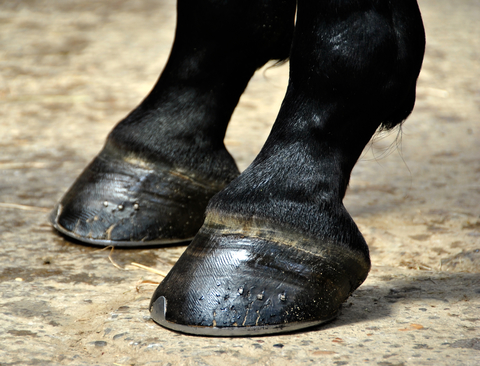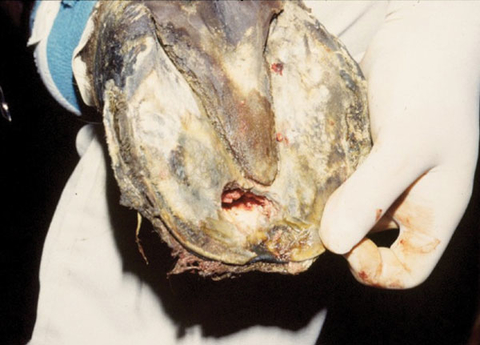Quick facts
Establish a good working relationship with your farrier and veterinarian to ensure your horse stays healthy and sound. Many foot problems can occur in horses. To reduce hoof problems:
- Schedule regular trimming or shoeing.
- Maintain good hoof balance.
- Provide appropriate shoeing for different weather and footing conditions.
- Provide appropriate treatment when disease occurs.
- Maintain proper horse nutrition.
How often should your horse’s feet by trimmed or shod?
Summer
Trim or shoe hooves at least every 6 to 8 weeks in the summer. Show horses may need more frequent trimming.
Winter
Because the horse’s hooves grow slower in the winter, you should trim or shoe hooves every 6 to 12 weeks. This time interval may be different between horses based on their hoof growth.
Keeping the hooves balanced
Horses with balance hooves move better, and have less stress and strain on bones, tendons and ligaments. The ideal foot has:
- A straight hoof-pastern angle
- A straight line from the pastern down through the front of the hoof wall.
- This correctly lines up the bones between the pastern and coffin bone.
- Easy break over
- The toe is not too long and is squared, rounded or rolled.
- This allows easier movement with each step.
- Too much break over can result in health problems.
- Adequate heel support
- The shoe extends back to the end of the hoof wall and supports the back of the entire leg.
- The back edge of the shoe is under a line drawn down the center of the cannon bone.
- Medial-lateral balance
- The foot lands evenly from side to side as the horse walks.
Learn how to care for horse hooves in the winter.
Nutrition can help some hoof problems
- Feed good quality hay.
- Correctly supplement vitamins and trace minerals.
- Provide constant access to fresh, clean water.
- Correct poor nutrition can lead to gradually improve hoof health.
- Cooperate with veterinarians and horse nutritionists to set up a good nutrition plan.
Research shows poor quality hooves can benefit from commercially available hoof care products that contain:
- Biotin (20 milligrams per day)
- Iodine (1 milligram per day)
- Methionine (2500 milligrams per day)
- Zinc (175 to 250 milligrams per day)
Common hoof problems
Poor shoeing or trimming
- Long toes and collapsed heels
- Strains flexor tendons and the navicular bone
- Short toes and long heels
- Cause trauma to the coffin bone and joint
- Imbalanced hooves
- Causes stress on supporting ligaments and joints
Hoof cracks
Causes
- Dry weather, or frequent changes from wet to dry
- Drawn-out trimming intervals and long toes
- Poor hoof quality, some horses may be born with it
Treatment tips
- Apply hoof moisturizers to the hoof wall and sole during:
- Dry weather
- Periods of brittle or cracking hooves
- Provide good nutrition and commercially available hoof supplements to improve hoof quality
- Regularly trim your horse’s hooves
Types of hoof cracks
Horizontal cracks and blowouts
Horizontal cracks and blowouts occur following injury to the coronary band or blow to the hoof wall. This hoof problem generally doesn’t cause lameness.
Grass cracks
Grass cracks commonly occur in horses with long, unshod hooves Trimming and shoeing can correct these cracks.
Sand cracks
Sand cracks result from injury to the coronary band or white line disease that breaks out at the coronary band. Sand crack may result in lameness.
Treatments can include:
-
Determining the cause of the cracks and removing it
-
Floating the hoof wall (not letting it bear weight)
-
Patching the crack
It usually takes nine to 12 months for a horse’s hoof to grow out.
Thrush
Thrush is a foul-smelling black oozy liquid around the frog. Thrush occurs in wet, soiled conditions. Thrush invades the sensitive tissues of the hoof and causes lameness. You can treat by keeping your stalls or barn clean and dry.
Solar abscess
A solar abscess is an infection in the sole of the hoof. Solar abscesses lead to sudden or severe lameness. Causes of solar abscess include trauma, bruising, or a foreign body.
Treatments include:
- Removing the foreign body (if possible)
- Soaking the hoof in warm water and Epsom salt
- Keeping the hoof bandaged, clean, and dry
Hot nail
A hot nail is a horseshoe nail within a sensitive area of the horse’s hoof. Hot nails will generally cause lameness.
Treatments include:
- Cleaning the nail hole with antiseptic, a wash that prevents germ growth
- Packing the hole or bandaging the foot
- Providing a Tetanus booster
Street nail
A street nail is any foreign object that enters the horse’s foot. Call your veterinarian immediately if your horse has a street nail. Treatment will depend on the location of the injury.
Laminitis and founder
Laminitis is swelling of the sensitive laminae. The lamina is a connective tissue located inside the hoof. Swelling causes the coffin bone to rotate or sink downward within the hoof. There are several causes of laminitis.
Treatments include:
- Regular shoeing or trimming
- Keeping short toes
- Keeping frog and sole support
Navicular
Navicular disease involves the navicular bone, bursa, ligamentous, and/or soft tissue structures. Horses affected by navicular will usually step toe-first because of heel pain.
Causes of navicular:
- Inheritance (Quarter Horses and Thoroughbreds)
- Poor conformation
- Hoof imbalance
- Exercise on hard surfaces
Treatments include:
- Shoeing
- Keeping a short toe
- Elevating the heels
- Having a good break over
- Pads
Reviewed in 2021




